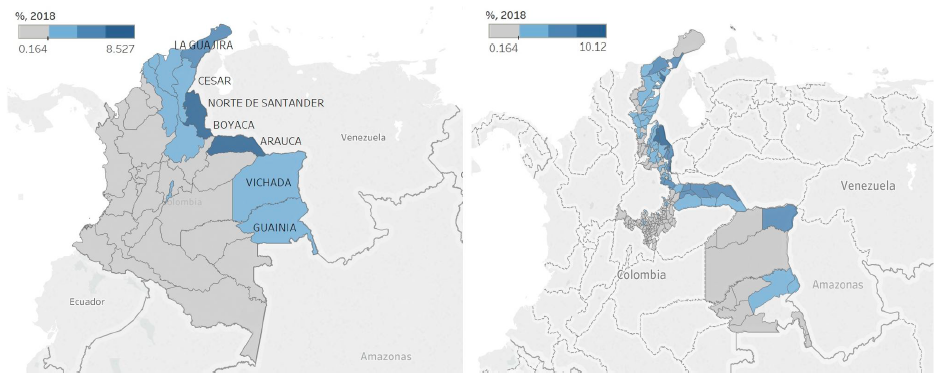Editor’s note: This post is part of a series showcasing BSE master projects. The project is a required component of all Master’s programs at the Barcelona School of Economics.
Abstract
How does a sudden migrant crisis affect criminal activity, and through which mechanisms does this effect take place? We approach this topic by studying the effect of Venezuelan migration on crime rates in Colombia, in the context of the recent migrant crisis that made more than 1.2 million Venezuelans cross the border.
Our study focuses on border provinces, where the presence of non-economic migrants is higher and potential assimilation problems could be exacerbated. Building on the fact that Venezuelan migration to Colombia happened due to apparently exogenous reasons and is unrelated to economic outcomes in the latter, we are able to study the causal effect of this large migration wave on crime rates.
Our results show that Venezuelan forced migration had no significant effect on overall crime, but a positive and significant effect on personal theft in Colombian border provinces. Furthermore, migration had a positive and significant effect on personal theft victimization rates of both Venezuelans and Colombians, while only having significant effects on the criminalization rates of Venezuelans. These results are robust to different specifications and controls, and two placebo tests provide strong evidence in favor of our empirical strategy and results. Finally, we link our findings with the overarching criminal context in Colombian border provinces, and develop relevant policy recommendations based on our findings.
Conclusions
In this paper we analyzed the impact of the Venezuelan migrant crisis, which saw more than 1.2 million Venezuelans cross the border, on crime rates in Colombian border provinces between 2014 and 2018. We focused on the border provinces to study the particular effects of non-economic migration, as we find that migrants in this area did not target areas with specific characteristics but just settled in the closest center to get food, medicine and essential services. This settlement decision strictly based on closeness to border is also illustrated by the figure below: not only is the highest share of foreign-born population in the Colombian regions concentrated in our area of study (the 7 border provinces), but within these border provinces there is also a clear concentration in municipalities on the physical border with Venezuela.

The main contribution of our study was presenting compelling and robust evidence on no significant effect of Venezuelan forced migration on overall crime, but a positive and significant effect on personal theft in Colombian border provinces. By also analyzing both the direct and indirect mechanisms through which this migration inflow can have an effect on different crime rates, we’re able to establish a causal effect of migration on both personal theft victimization and criminalization rates of Venezuelans, while only having significant effects on the victimization rates of Colombians.
Besides our key findings, other results hint at a more holistic narrative: migration also had a positive and significant effect on both homicide and personal injury victimization rates of Venezuelans. What could be driving these effects? As seen previously, Venezuelan migrants settled in municipalities right across the border from Venezuela – which, coincidentally, are municipalities where criminal organizations have a large presence: criminal organizations are present in 23 of the 42 municipalities on the border, and in 39 of the 81 municipalities where the change in proportion of Venezuelan migrants between 2014-18 was above the average.
In these high migration municipalities, as a consequence of criminal activity, homicide rates tended to be much higher at baseline than in other municipalities. Moreover, we see some evidence of discrimination in homicides – after controlling for all relevant socioeconomic covariates, being Venezuelan seems to have a significant and positive effect on being a victim of homicide.
This additional information could help construct the following holistic narrative and recommendations:
- A large wave of migrants arrived in low-income border provinces with little (formal) employment opportunities, and some had to resort to small-scale theft to make a living, which explains the positive effect of migration on Venezuelan personal theft criminalization rates
- Driven by both opportunity and attractiveness of targets, this caused an increase in personal theft victimization rates for both Colombians and Venezuelans, although it was much higher for the former than for the latter.
- However, these municipalities were controlled largely by criminal organizations, which started threatening Venezuelans and forcefully recruiting them in large numbers. This could help explain the positive and significant effect of migration on both homicide and personal injury victimization rates of Venezuelans.
- These findings imply that government policies should focus on reducing the vulnerability of Venezuelans by providing swift access to the formal labor market, either in border provinces or nationwide, so that Venezuelans can avoid resorting to small-scale theft and escape forced recruitment and exploitation from criminal organizations.
Connect with the authors
- Maria Dale: LinkedIn
- Giacomo Gattorno: LinkedIn
- Andre Osorio: LinkedIn
- Rebeca Peers: LinkedIn
- Kerenny Torres: LinkedIn
About the BSE Master’s Program in International Trade, Finance, and Development
